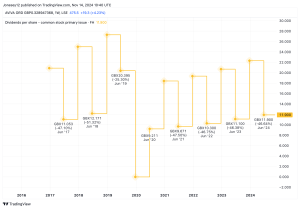Earning a second income by investing in blue-chip shares is a proven model already used by a lot of people to boost their earnings.
It is not foolproof. Dividends are never guaranteed, even from companies that have paid them consistently in the past. But by carefully selecting a diversified range of shares, I believe it is possible to earn sizeable passive income streams.
If that was my objective and I had £20,000 in a Stocks and Shares ISA to try and bring it to life, here are three steps I would take.
1. Building a portfolio of high-quality shares
Some shares offer dizzying dividends – but they may not last. Rather than put all my second income eggs in one basket, I would spread the £20k across five to 10 different shares.
Dividends will be my income source in this plan, so yield matters – the higher a yield, the more I should earn relative to what I invest. But simply chasing yield can be a fool’s errand.
So my starting point would be to identify excellent businesses I felt were trading at an attractive share price. Only then would I look at yield.
2. Reinvesting dividends along the way
Having bought those shares, I would then reinvest the dividends. That simple move would allow me to buy more shares, growing my portfolio and hopefully therefore the income it produced.
This is known as compounding. It can be a very powerful tool for investors over the long term, boosting the amount of income earned without needing to put more cash into the ISA.
As an example, if I invested my £20k ISA and compounded its value at 7% annually, down the line, it should hopefully generate a second income of £5,418 each year.
In the current market, I think a 7% average yield is viable even while sticking to proven blue-chip firms. As an example, consider one share I own that actually has a higher yield right now, of 9.5%: M&G (LSE: MNG).
The asset management market is vast and I expect it to stay that way over time. M&G has a well-known brand and has spent decades building a customer base that stretches across over two dozen markets and numbers in the millions. It has proven that it can generate substantial excess cash from its operations, supporting a chunky dividend. Indeed, it aims to maintain or grow its dividend annually and has done that over the past few years.
Whether that continues depends on how the business does. One risk I see is the next market downturn scaring investors, leading them to pull funds from M&G and hurting its earnings.
3. Taking a long-term approach
As a long-term investor, though, I continue to like the prospects for M&G.
The long-term approach is critical to my plan. I said above that compounding the £20k at 7% would hopefully earn me £5,418 in second income down the line.
How far down the line? 20 years. That may sound like a long time, but I think patience here would pay off!
This post was originally published on Motley Fool







